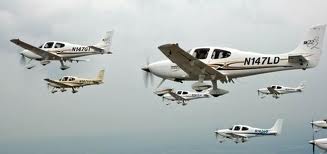High Performance Aviation
Expect Vectors to Final, Part I
By Hank Gibson, Gold Seal, CFI, CFII, MEI
A lot of pilots these days don’t get a lot of actual IFR time, so they don’t have to shoot many actual IFR approaches. This leads to pilots quickly getting rusty on approach briefings and procedures. Cirrus has published their Flight Operations Manual (FOM) to provide standardized guidance on how to perform all the normal flight maneuvers, including instrument approach guidance. To help knock some of that rust off, here’s an overview of the way Cirrus wants pilots to fly approaches in the SR22. (Note: All information below is taken from the Cirrus Flight Operations Manual for the SR20 and SR22).

The Cirrus Approach Briefing
There are many different ways to brief an instrument approach, some more simplified then others. As pilots finish training, most quickly discover the briefing they were taught during their instrument course isn’t very practical to the real world. Often, the result is they don’t learn a simplified way to brief approaches. Cirrus is here to help. Here is the flow the company published for an instrument approach briefing:
- Type of Approach and Runway
- First and foremost, figure out what type of approach it is, whether an ILS, GPS WAAS, localizer, RNAV/GPS, VOR, or (gasp, these still exist?) an NDB approach.
- Then determine what runway the approach is for. This seems kind of obvious, but if the airport has several RNAV approaches, make sure the plate you are looking at is for the correct runway.
- Finally, load the approach into the Garmin 430.
- Transition to Final
- This one is pretty easy. Are you getting vectors or are you flying to a specific Initial Approach Fix (IAF)?
- Frequencies
- Now, brief the communication and navigation frequencies. For the Com frequencies, make sure you’ve got the proper approach frequency in. Put the tower or CTAF in standby on whichever radio you are using. Tune the ATIS/ASOS/AWOS on the other radio and listen to it. Be ready to tune in the ground frequency once you land.
- As far as Nav frequencies go, for ILS, LOC, or VOR approaches, make sure the proper Navaid frequency is tuned in AND activated. Always identify the Navaid to make sure the signal is reliable. Remember to change the HSI from GPS to VLOC if you are flying one of these approaches. Traditional Navaid approaches are not allowed to be flown using the GPS, even though the procedure is showing on the Garmin 430.
- Altitudes
- Brief the Final Approach Fix (FAF) altitude (or the glide slope intercept altitude for an ILS) and the Decision Altitude (precision approach) or Minimum Descent Altitude (non-precision approach).
- Cirrus doesn’t say it, but I would include briefing the Final Approach Course (FAC) heading here too.
- Missed Approach Procedure
- Last, but not least, brief the missed approach procedure. What headings do you need to fly? What altitudes should you climb to? Where are you supposed to hold?
- If you do have to go missed, don’t forget to press the OBS button while flying the missed approach procedure. Otherwise, the GPS won’t cycle over to the procedure.
Precision Approach Procedures
When getting vectors to the FAC or flying to the initial approach fix, Cirrus recommends to slow to 120 knots, using whatever power setting is necessary to get slowed. In the SR22, this would probably be somewhere in the area of 20-30%. Once you are turned by ATC to intercept the FAC (if getting vectors) or procedure turn inbound, slow to 100 knots (10-20% power) and set the heading bug for the final approach course. Once you are a dot below the glide slope, this is where the flaps come in. Here, the altitude bug should be set to the decision altitude (DA). 50% flaps and 100 knots is the proper configuration to shoot any approach with. This is also the time to check to make sure your GPS has switched to Approach (APR) mode if shooting a GPS approach.
As you descend on the GS, the power should remain between 10-20%, depending on what it takes to hold 100 knots. Also, at the FAF, note the time, as all ILS plates have published how long it takes to get from the FAF to the missed approach point (MAP). At the DA, either land or go missed. For the missed approach, push the power lever full, pitch up to 7.5-10 degrees, and start climbing. Flaps should be retracted once you are clear of any obstacles and have a positive rate of climb (which, in the SR22, doesn’t take very long!). The OBS button should be pressed on the 430 to cycle the Garmin GPS over to the missed approach procedure.
Non-Precision Approaches
With a non-precision approach, the procedure is the same as with a precision approach, with the exception of where to put the flaps down. Since there is no glide slope to reference, Cirrus instructs the pilot to lower the flaps to 50% two nautical miles prior to the FAF. Other than that, everything else remains the same. 50% flaps and 100 knots on final.
Cirrus doesn’t mention this, but when flying a non-precision approach, don’t have a descent rate any less than 500 feet per minute into a headwind. If you keep the airplane descending at 300 feet per minute, you’ll never get down to the MDA in time. You’d rather get to the MDA early then late. Just make sure you don’t go below the MDA until you see the runway environment.
What about the autopilot, you ask? Well, come back next week and I’ll explain how to work the S-TEC autopilot for instrument approaches.
Would you like more information?
Send us a message below.

